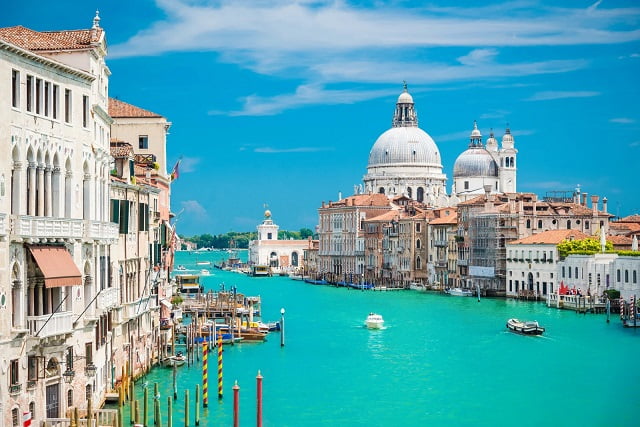When can Americans travel to Italy? As the world continues to navigate through the COVID-19 pandemic, travel restrictions have heavily impacted international travel. Americans looking to visit Italy have faced numerous challenges due to the global health crisis. From border closures to quarantine regulations, the process of traveling to Italy has undergone significant changes in response to the pandemic.
The impact of COVID-19 on travel to Italy has been widespread, as the Italian government implemented strict measures to prevent the spread of the virus. These measures included strict limitations on who could enter the country and mandatory quarantine periods for those who were allowed entry. As a result, American travelers have had to carefully consider when it would be feasible for them to visit Italy.
Recently, there has been progress towards easing travel restrictions and reopening borders for American travelers looking to visit Italy. The Italian government has taken steps towards welcoming tourists back while ensuring public safety remains a top priority. With these developments, many are eager to understand what requirements and regulations are in place for American travelers planning a trip to Italy. By staying informed about these updates, individuals can better plan and prepare for their upcoming travels.
The Impact of COVID-19 on Travel to Italy
The COVID-19 pandemic has significantly impacted travel to Italy, with the country implementing strict measures to control the spread of the virus. Italy was one of the first countries in Europe to be heavily affected by the pandemic, leading to the closure of borders and a halt in international travel. This had a major impact on tourism, an industry that is crucial to Italy’s economy.
Travel Restrictions and Border Closures
At the height of the pandemic, Italy closed its borders to non-essential travel from countries with high infection rates, including the United States. This meant that Americans were unable to travel to Italy for tourism or leisure purposes. The restrictions were put in place to protect public health and prevent further transmission of COVID-19.
Economic Impact
The closure of borders and restrictions on travel had a severe economic impact on Italy, especially on businesses that rely heavily on tourism. Hotels, restaurants, tour operators, and other related industries suffered significant losses as a result of the decrease in international visitors. As one of the most popular tourist destinations in the world, Italy felt the effects of reduced travel and tourism activities.
Future Outlook
As vaccination efforts continue and infection rates decrease, there is optimism for a gradual reopening of borders and a return to normalcy for travel to Italy. With ongoing discussions about vaccine passports and testing requirements, it is likely that Americans will soon be able to visit Italy for tourism once again. However, it is important for travelers to stay informed about current regulations and requirements when planning their trips to Italy amidst ongoing developments related to COVID-19.
The Reopening of Borders and Easing of Travel Restrictions
As the world continues to grapple with the COVID-19 pandemic, many countries, including Italy, have implemented travel restrictions to curb the spread of the virus. Americans have been particularly affected by these restrictions, as travel to Italy has been limited for much of the past year. However, with the rollout of vaccination programs and declining infection rates in some areas, Italy has started to ease its travel restrictions and reopen its borders to international visitors.
As of now, Americans can travel to Italy for essential reasons such as work, health reasons, study, or urgent family matters. Non-essential travel for tourism purposes is still restricted for American travelers. However, this situation is fluid and subject to change based on the current COVID-19 situation and government guidelines. It’s essential for Americans planning a trip to Italy to stay updated on the latest travel advisories and entry requirements.
American travelers will need to comply with specific entry requirements when traveling to Italy. These requirements may vary based on vaccination status or recent exposure to COVID-19. For example, unvaccinated travelers may be required to present a negative PCR test result taken within a certain timeframe before arrival in Italy. Vaccinated travelers may have different testing or quarantine requirements. It’s important for travelers to thoroughly research and understand these requirements before planning their trip.
| Entry Requirement | Details |
|---|---|
| COVID-19 Testing | All travelers are required to present proof of a negative COVID-19 PCR test taken within 72 hours of arrival. |
| Vaccination Status | Vaccinated individuals are exempt from quarantine but must present proof of full vaccination at least 14 days prior arrival. |
| Self-isolation | Unvaccinated travelers coming from certain countries may be required to self-isolate upon arrival in Italy. |
Requirements for American Travelers to Enter Italy
As of the latest update, Americans can travel to Italy under certain conditions. The reopening of borders and easing of travel restrictions has allowed for a resumption of tourism and non-essential travel from the United States to Italy. However, it is important for American travelers to be aware of the specific requirements for entering Italy.
One of the primary requirements for American travelers to enter Italy is proof of vaccination or a negative COVID-19 test result. As of now, travelers from the United States must provide evidence of being fully vaccinated with an approved vaccine or present a negative test result from a molecular or antigenic test taken within a specified timeframe before their arrival in Italy.
In addition to vaccination or testing requirements, American travelers must also complete a digital Passenger Locator Form (dPLF) prior to entering Italy. The dPLF includes personal information, contact details, travel itinerary, and other relevant data that is used for monitoring and tracing purposes. It is essential for travelers to ensure that they have completed this form accurately and in advance of their trip to Italy.
| Requirement | Description |
|---|---|
| Vaccination or Negative Test Result | American travelers must show proof of full vaccination or a negative COVID-19 test result. |
| Passenger Locator Form | A completed digital Passenger Locator Form (dPLF) is required before entering Italy. |
COVID-19 Testing and Vaccination Requirements
As of June 2021, Italy has eased its travel restrictions for American travelers. However, in light of the ongoing COVID-19 pandemic, there are certain testing and vaccination requirements that Americans must meet in order to enter Italy. It is important for travelers to understand these requirements before planning their trip to Italy.
COVID-19 Testing Requirements
One of the main requirements for American travelers entering Italy is the presentation of a negative COVID-19 test result. The test must be taken within a specified timeframe before departure to Italy, typically no more than 72 hours prior to arrival. It is essential to ensure that the type of test conducted and the timing of the test complies with Italy’s entry requirements to avoid any issues upon arrival.
Vaccination Requirements
In addition to testing requirements, Italy may also have specific guidelines regarding vaccination for American travelers. As vaccination efforts continue across the United States, it is crucial for travelers to stay updated on the recognized vaccines and any additional documentation required for entry into Italy. Some regions or establishments within Italy may also have their own vaccination policies, so it is advisable to research thoroughly before embarking on the trip.
Traveler Responsibility
It is important for American travelers planning a trip to Italy to take personal responsibility in understanding and adhering to the COVID-19 testing and vaccination requirements set forth by Italian authorities. Failure to comply with these regulations may result in denial of entry or other consequences that could disrupt travel plans.
Additionally, keeping abreast of any updates or changes to these requirements leading up to the trip will help ensure a smooth and hassle-free travel experience when can Americans travel to Italy.
Quarantine and Self-Isolation Regulations
Since the outbreak of COVID-19, Italy has implemented various measures to control the spread of the virus, including quarantine and self-isolation regulations for incoming travelers. These regulations have had a significant impact on Americans wanting to travel to Italy.
As of now, Americans are allowed to travel to Italy, but they must adhere to specific quarantine and self-isolation requirements upon arrival. It is important for travelers to be aware of these regulations in order to plan their trip effectively.
Below are the current quarantine and self-isolation regulations for American travelers entering Italy:
- All passengers arriving in Italy from the United States are required to undergo a 10-day quarantine period. This can be reduced to 5 days with a negative COVID-19 test result taken after the fifth day of quarantine.
- Travelers must also complete a self-declaration form stating that they agree to comply with the mandatory quarantine or isolation period.
- It is important for travelers to stay updated on any changes or updates to these regulations, as they may be subject to change based on the current situation with COVID-19.
In addition to these requirements, it is essential for American travelers planning a trip to Italy to research and understand all the necessary protocols in place before making any travel arrangements.
Tips for Planning a Trip to Italy
Planning a trip to Italy can be an exciting and rewarding experience, especially after the easing of travel restrictions due to the COVID-19 pandemic. As Americans eagerly await the opportunity to visit this beautiful country once again, there are some important tips to keep in mind when preparing for your trip.
Here are some tips for Americans planning a trip to Italy:
- Check Current Travel Restrictions: Before making any travel arrangements, ensure that you are up to date with the latest travel restrictions and entry requirements for Americans traveling to Italy. Stay informed about any changes or updates regarding entry regulations, testing requirements, and quarantine measures.
- Book Accommodations in Advance: With the anticipation of increased travel demand, it is advisable to book your accommodations in advance. Whether you prefer staying in hotels, bed and breakfasts, or vacation rentals, securing your lodging early can help ensure that you have options that meet your preferences and budget.
- Plan Your Itinerary: Italy is a country rich in history, culture, and stunning landscapes. Take the time to research and plan your itinerary based on your interests and the attractions you want to visit. Whether you’re drawn to iconic landmarks like the Colosseum in Rome or the art-filled streets of Florence, having a well-planned itinerary can maximize your experience while exploring this fascinating country.
As travel gradually resumes between the United States and Italy, it’s essential for American travelers to prepare accordingly by staying informed about entry requirements and planning their trip strategically. By following these tips, travelers can look forward to a memorable experience as they explore all that Italy has to offer.
Conclusion
As the world continues to navigate the challenges brought about by the COVID-19 pandemic, there is hope on the horizon for American travelers looking to visit Italy. The impact of COVID-19 on travel to Italy has been significant, with strict travel restrictions and border closures in place for an extended period. However, as vaccination efforts ramp up and infection rates decline, Italy has begun to reopen its borders and ease travel restrictions for visitors from the United States.
While specific timelines may vary, it is important for Americans to stay updated on the latest information regarding when they can travel to Italy. Requirements for entry into Italy may include proof of vaccination, negative COVID-19 testing results, or adherence to quarantine and self-isolation regulations. It is crucial for travelers to familiarize themselves with these requirements and plan accordingly before embarking on their journey abroad.
Looking ahead to the future of travel to Italy for Americans, there is optimism that continued progress in managing the COVID-19 pandemic will lead to more accessible and seamless travel experiences. As Italy adapts its policies and procedures to accommodate safe travel, it is essential for Americans to remain flexible and informed when planning their trips.
With careful preparation and adherence to guidelines, the prospect of visiting the enchanting landscapes, rich history, and vibrant culture of Italy once again becomes a promising reality for eager travelers from across the Atlantic.
Frequently Asked Questions
Does Italy Allow US Citizens to Travel?
Yes, Italy currently allows US citizens to travel to the country. However, there may be certain entry requirements and restrictions in place due to the COVID-19 pandemic, so it’s important to check for the latest updates before planning a trip.
Can I Travel to Italy With Less Than 6 Months on Passport?
Yes, US citizens can travel to Italy with less than 6 months on their passport. Italy only requires that the passport be valid for at least three months beyond the planned date of departure from the Schengen area.
What Is the Current Travel Advisory for Italy?
As of now, the US Department of State has issued a Level 3 Travel Advisory for Italy, advising travelers to reconsider travel due to COVID-19. While some areas of Italy have been designated as Level 4 due to high levels of COVID-19 cases, others may have lower advisories based on local conditions.
It’s important for travelers to stay updated on the current travel advisory for specific regions within Italy.

I’m a passionate traveler, writer, and Italophile. My fascination with Italy’s history, art, and culture has led me on countless adventures across the Italian landscape. Through “I Live Italy,” I share my love for this extraordinary country and aims to inspire others to explore its boundless beauty.




